Analysing Corporate Governance Failures & Stakeholder Roles
VerifiedAdded on 2023/05/30
|9
|1217
|487
Report
AI Summary
This report examines corporate governance failures through case studies of Enron, Parmalat, and the banking sector during the 2008 financial crisis. It identifies unethical practices, lack of oversight, and compromised auditor independence as key contributing factors. The report emphasizes the importance of directors fulfilling their fiduciary duties and auditors maintaining professional competence. It concludes that a robust corporate governance strategy, coupled with a strong internal control system, is crucial for long-term business success and brand value. Desklib provides access to similar solved assignments and past papers for students.
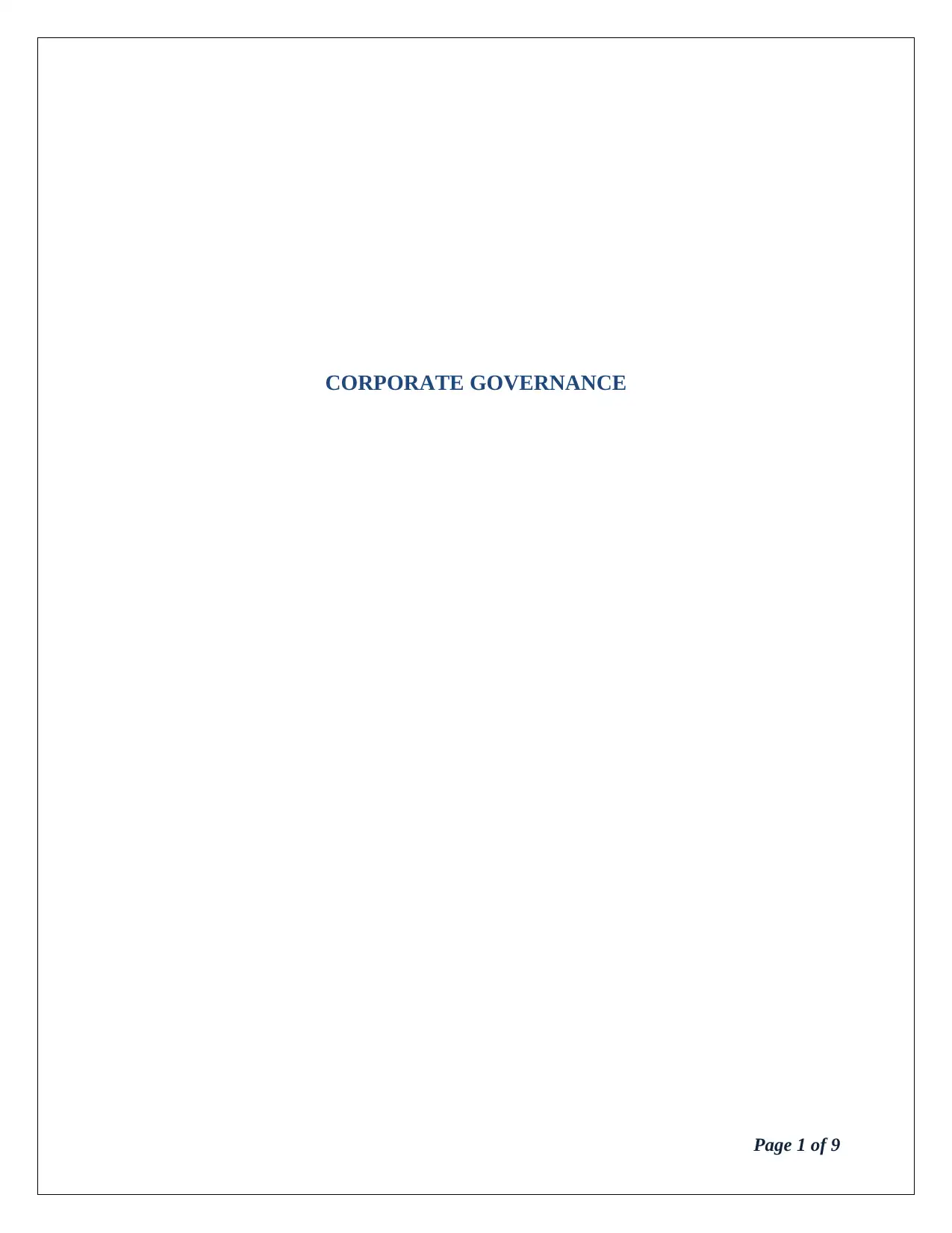
CORPORATE GOVERNANCE
Page 1 of 9
Page 1 of 9
Paraphrase This Document
Need a fresh take? Get an instant paraphrase of this document with our AI Paraphraser
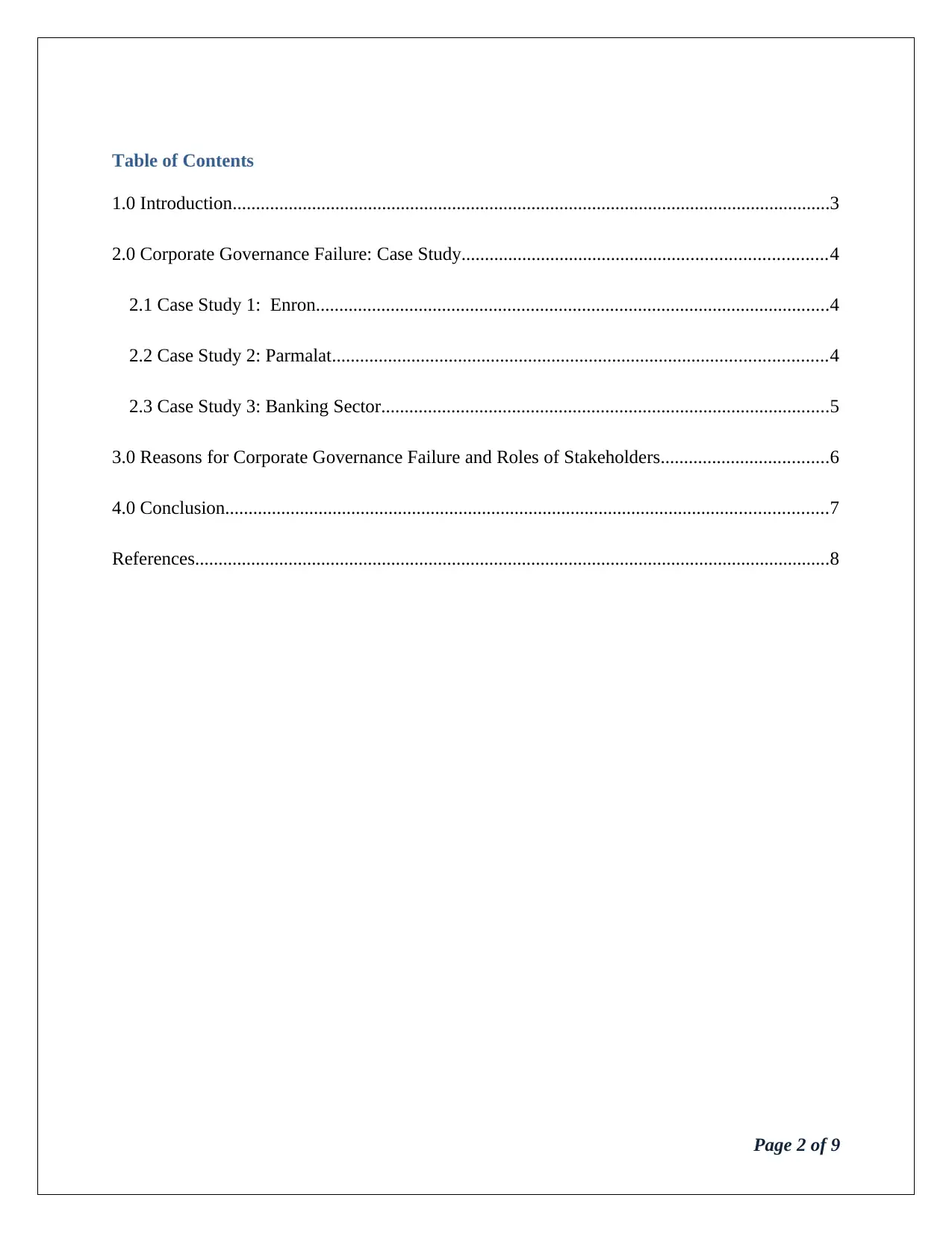
Table of Contents
1.0 Introduction................................................................................................................................3
2.0 Corporate Governance Failure: Case Study..............................................................................4
2.1 Case Study 1: Enron..............................................................................................................4
2.2 Case Study 2: Parmalat..........................................................................................................4
2.3 Case Study 3: Banking Sector................................................................................................5
3.0 Reasons for Corporate Governance Failure and Roles of Stakeholders....................................6
4.0 Conclusion.................................................................................................................................7
References........................................................................................................................................8
Page 2 of 9
1.0 Introduction................................................................................................................................3
2.0 Corporate Governance Failure: Case Study..............................................................................4
2.1 Case Study 1: Enron..............................................................................................................4
2.2 Case Study 2: Parmalat..........................................................................................................4
2.3 Case Study 3: Banking Sector................................................................................................5
3.0 Reasons for Corporate Governance Failure and Roles of Stakeholders....................................6
4.0 Conclusion.................................................................................................................................7
References........................................................................................................................................8
Page 2 of 9
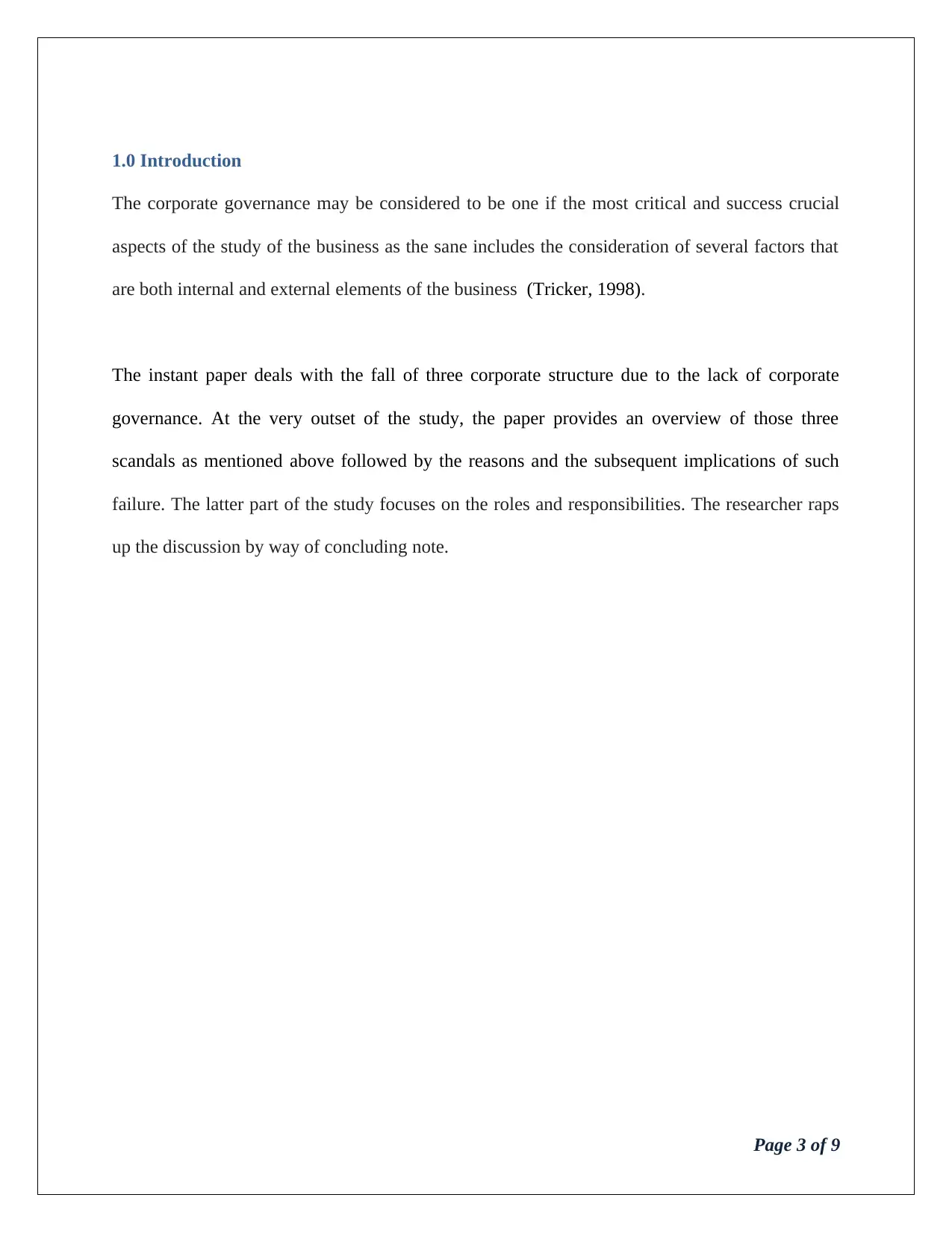
1.0 Introduction
The corporate governance may be considered to be one if the most critical and success crucial
aspects of the study of the business as the sane includes the consideration of several factors that
are both internal and external elements of the business (Tricker, 1998).
The instant paper deals with the fall of three corporate structure due to the lack of corporate
governance. At the very outset of the study, the paper provides an overview of those three
scandals as mentioned above followed by the reasons and the subsequent implications of such
failure. The latter part of the study focuses on the roles and responsibilities. The researcher raps
up the discussion by way of concluding note.
Page 3 of 9
The corporate governance may be considered to be one if the most critical and success crucial
aspects of the study of the business as the sane includes the consideration of several factors that
are both internal and external elements of the business (Tricker, 1998).
The instant paper deals with the fall of three corporate structure due to the lack of corporate
governance. At the very outset of the study, the paper provides an overview of those three
scandals as mentioned above followed by the reasons and the subsequent implications of such
failure. The latter part of the study focuses on the roles and responsibilities. The researcher raps
up the discussion by way of concluding note.
Page 3 of 9
⊘ This is a preview!⊘
Do you want full access?
Subscribe today to unlock all pages.

Trusted by 1+ million students worldwide
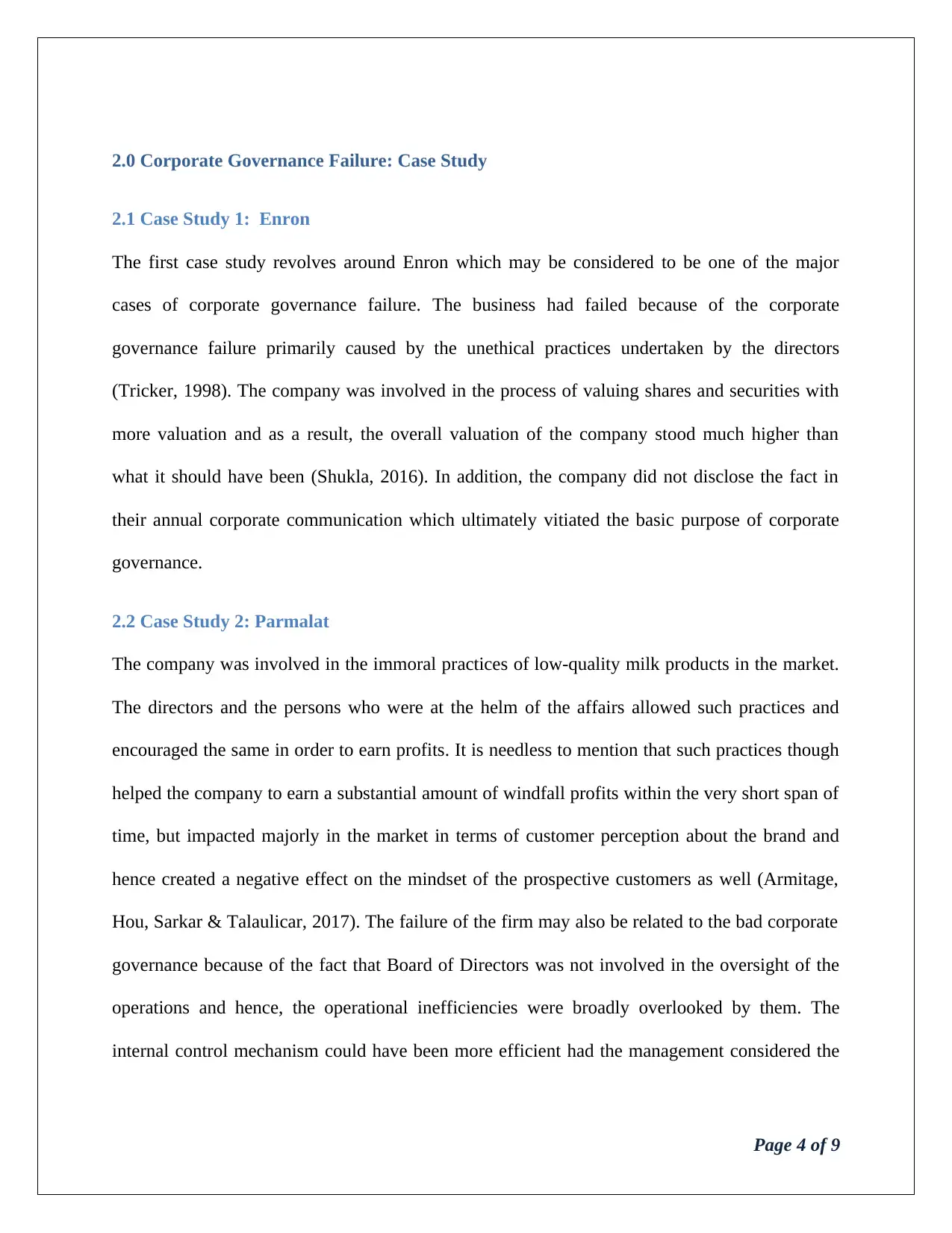
2.0 Corporate Governance Failure: Case Study
2.1 Case Study 1: Enron
The first case study revolves around Enron which may be considered to be one of the major
cases of corporate governance failure. The business had failed because of the corporate
governance failure primarily caused by the unethical practices undertaken by the directors
(Tricker, 1998). The company was involved in the process of valuing shares and securities with
more valuation and as a result, the overall valuation of the company stood much higher than
what it should have been (Shukla, 2016). In addition, the company did not disclose the fact in
their annual corporate communication which ultimately vitiated the basic purpose of corporate
governance.
2.2 Case Study 2: Parmalat
The company was involved in the immoral practices of low-quality milk products in the market.
The directors and the persons who were at the helm of the affairs allowed such practices and
encouraged the same in order to earn profits. It is needless to mention that such practices though
helped the company to earn a substantial amount of windfall profits within the very short span of
time, but impacted majorly in the market in terms of customer perception about the brand and
hence created a negative effect on the mindset of the prospective customers as well (Armitage,
Hou, Sarkar & Talaulicar, 2017). The failure of the firm may also be related to the bad corporate
governance because of the fact that Board of Directors was not involved in the oversight of the
operations and hence, the operational inefficiencies were broadly overlooked by them. The
internal control mechanism could have been more efficient had the management considered the
Page 4 of 9
2.1 Case Study 1: Enron
The first case study revolves around Enron which may be considered to be one of the major
cases of corporate governance failure. The business had failed because of the corporate
governance failure primarily caused by the unethical practices undertaken by the directors
(Tricker, 1998). The company was involved in the process of valuing shares and securities with
more valuation and as a result, the overall valuation of the company stood much higher than
what it should have been (Shukla, 2016). In addition, the company did not disclose the fact in
their annual corporate communication which ultimately vitiated the basic purpose of corporate
governance.
2.2 Case Study 2: Parmalat
The company was involved in the immoral practices of low-quality milk products in the market.
The directors and the persons who were at the helm of the affairs allowed such practices and
encouraged the same in order to earn profits. It is needless to mention that such practices though
helped the company to earn a substantial amount of windfall profits within the very short span of
time, but impacted majorly in the market in terms of customer perception about the brand and
hence created a negative effect on the mindset of the prospective customers as well (Armitage,
Hou, Sarkar & Talaulicar, 2017). The failure of the firm may also be related to the bad corporate
governance because of the fact that Board of Directors was not involved in the oversight of the
operations and hence, the operational inefficiencies were broadly overlooked by them. The
internal control mechanism could have been more efficient had the management considered the
Page 4 of 9
Paraphrase This Document
Need a fresh take? Get an instant paraphrase of this document with our AI Paraphraser
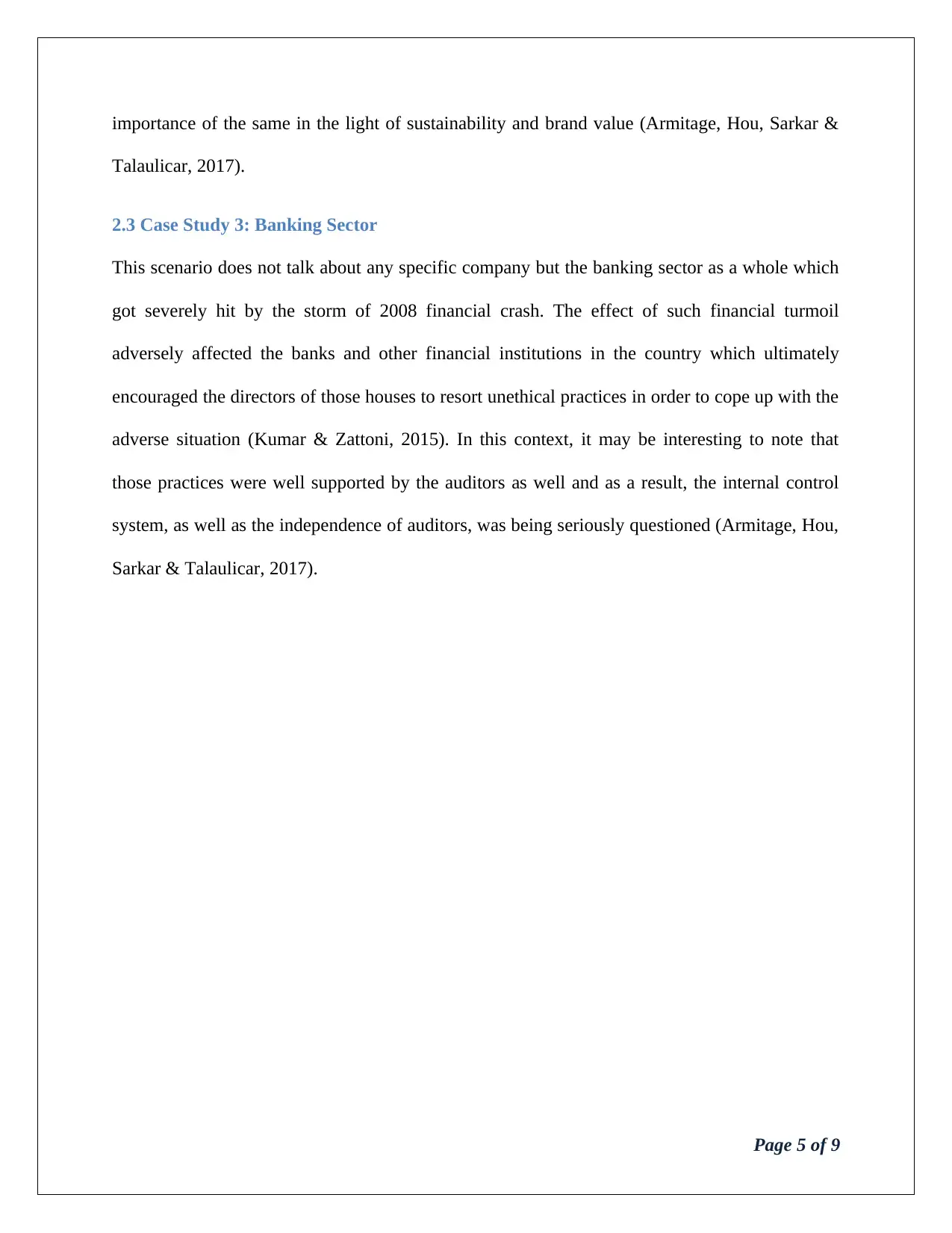
importance of the same in the light of sustainability and brand value (Armitage, Hou, Sarkar &
Talaulicar, 2017).
2.3 Case Study 3: Banking Sector
This scenario does not talk about any specific company but the banking sector as a whole which
got severely hit by the storm of 2008 financial crash. The effect of such financial turmoil
adversely affected the banks and other financial institutions in the country which ultimately
encouraged the directors of those houses to resort unethical practices in order to cope up with the
adverse situation (Kumar & Zattoni, 2015). In this context, it may be interesting to note that
those practices were well supported by the auditors as well and as a result, the internal control
system, as well as the independence of auditors, was being seriously questioned (Armitage, Hou,
Sarkar & Talaulicar, 2017).
Page 5 of 9
Talaulicar, 2017).
2.3 Case Study 3: Banking Sector
This scenario does not talk about any specific company but the banking sector as a whole which
got severely hit by the storm of 2008 financial crash. The effect of such financial turmoil
adversely affected the banks and other financial institutions in the country which ultimately
encouraged the directors of those houses to resort unethical practices in order to cope up with the
adverse situation (Kumar & Zattoni, 2015). In this context, it may be interesting to note that
those practices were well supported by the auditors as well and as a result, the internal control
system, as well as the independence of auditors, was being seriously questioned (Armitage, Hou,
Sarkar & Talaulicar, 2017).
Page 5 of 9
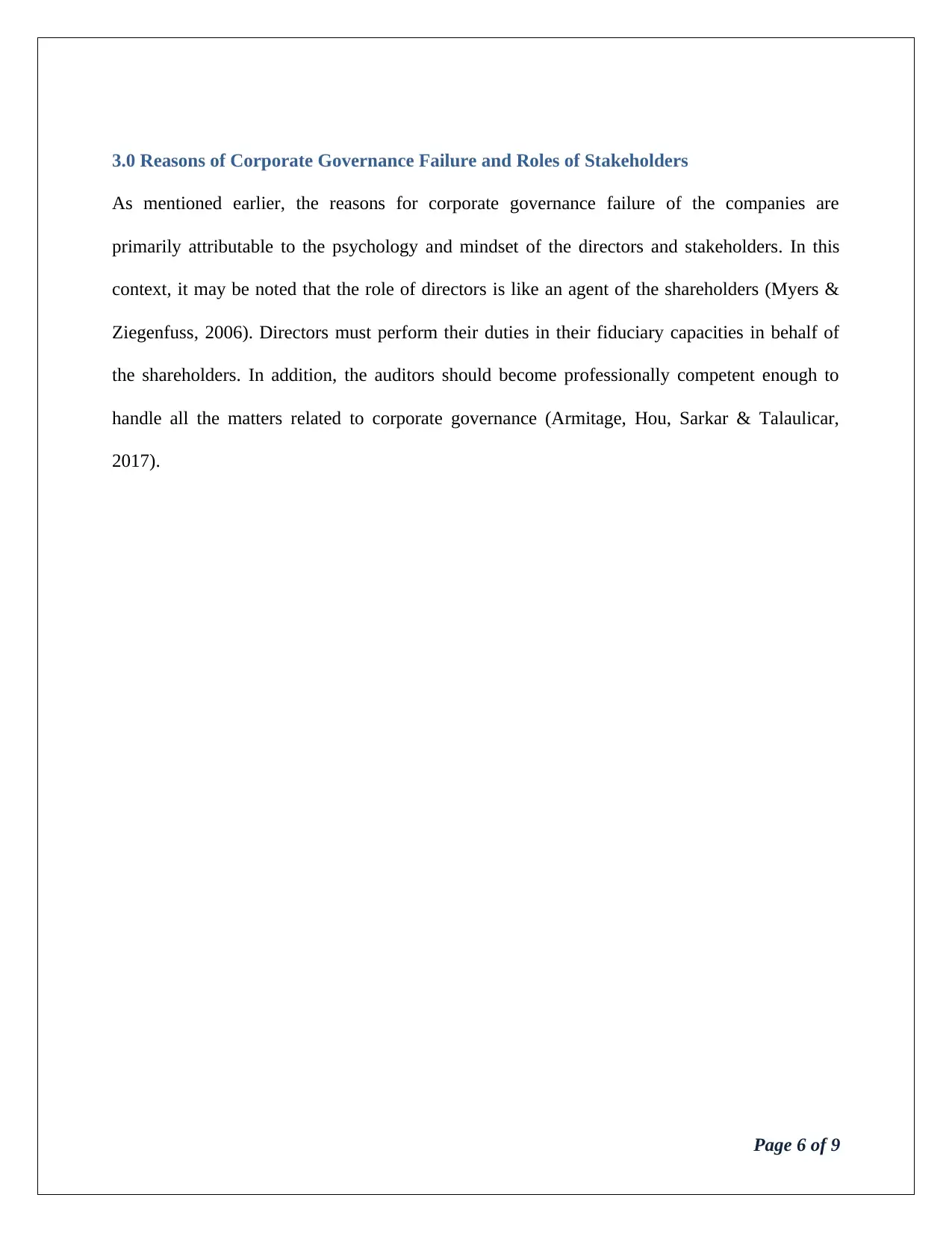
3.0 Reasons of Corporate Governance Failure and Roles of Stakeholders
As mentioned earlier, the reasons for corporate governance failure of the companies are
primarily attributable to the psychology and mindset of the directors and stakeholders. In this
context, it may be noted that the role of directors is like an agent of the shareholders (Myers &
Ziegenfuss, 2006). Directors must perform their duties in their fiduciary capacities in behalf of
the shareholders. In addition, the auditors should become professionally competent enough to
handle all the matters related to corporate governance (Armitage, Hou, Sarkar & Talaulicar,
2017).
Page 6 of 9
As mentioned earlier, the reasons for corporate governance failure of the companies are
primarily attributable to the psychology and mindset of the directors and stakeholders. In this
context, it may be noted that the role of directors is like an agent of the shareholders (Myers &
Ziegenfuss, 2006). Directors must perform their duties in their fiduciary capacities in behalf of
the shareholders. In addition, the auditors should become professionally competent enough to
handle all the matters related to corporate governance (Armitage, Hou, Sarkar & Talaulicar,
2017).
Page 6 of 9
⊘ This is a preview!⊘
Do you want full access?
Subscribe today to unlock all pages.

Trusted by 1+ million students worldwide
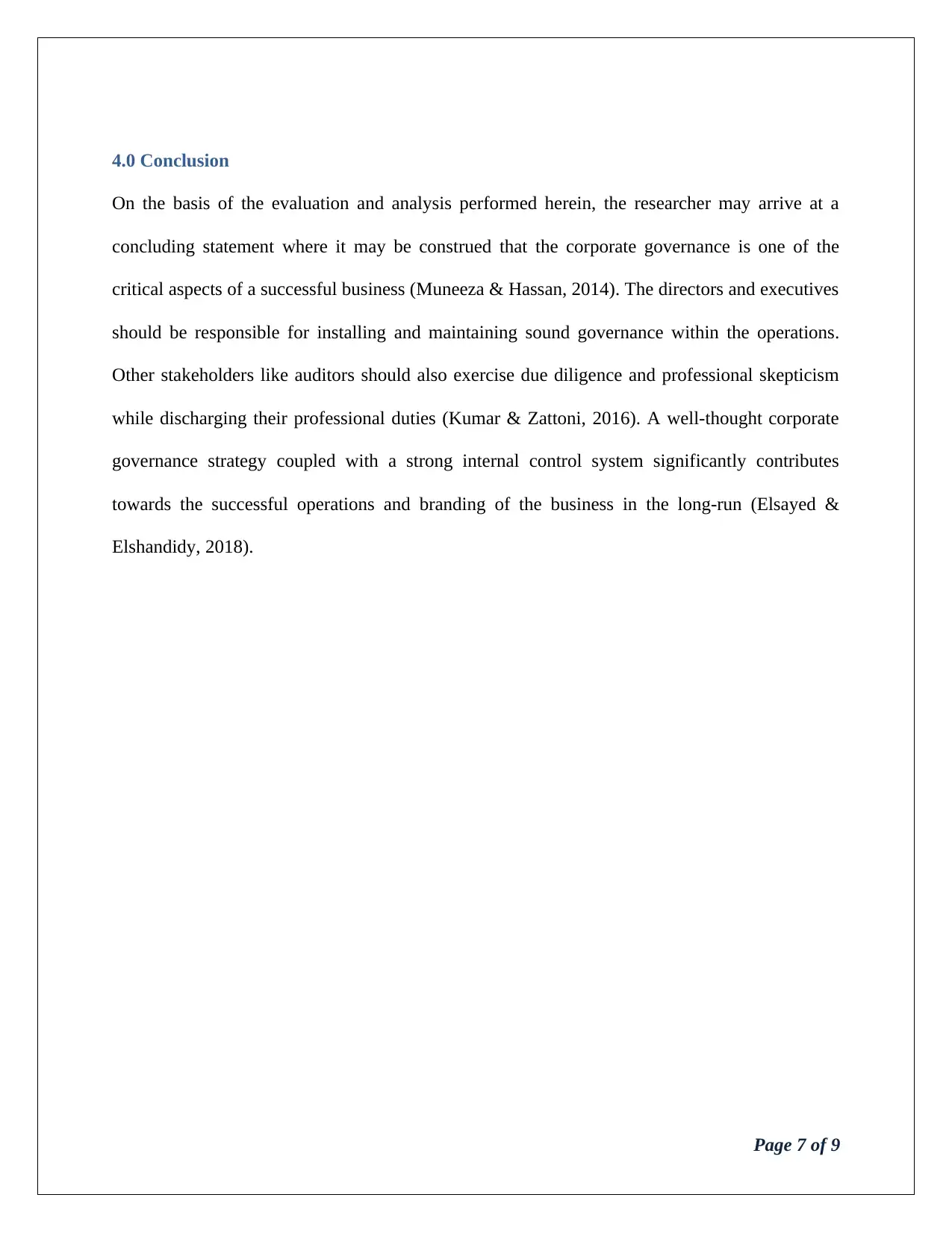
4.0 Conclusion
On the basis of the evaluation and analysis performed herein, the researcher may arrive at a
concluding statement where it may be construed that the corporate governance is one of the
critical aspects of a successful business (Muneeza & Hassan, 2014). The directors and executives
should be responsible for installing and maintaining sound governance within the operations.
Other stakeholders like auditors should also exercise due diligence and professional skepticism
while discharging their professional duties (Kumar & Zattoni, 2016). A well-thought corporate
governance strategy coupled with a strong internal control system significantly contributes
towards the successful operations and branding of the business in the long-run (Elsayed &
Elshandidy, 2018).
Page 7 of 9
On the basis of the evaluation and analysis performed herein, the researcher may arrive at a
concluding statement where it may be construed that the corporate governance is one of the
critical aspects of a successful business (Muneeza & Hassan, 2014). The directors and executives
should be responsible for installing and maintaining sound governance within the operations.
Other stakeholders like auditors should also exercise due diligence and professional skepticism
while discharging their professional duties (Kumar & Zattoni, 2016). A well-thought corporate
governance strategy coupled with a strong internal control system significantly contributes
towards the successful operations and branding of the business in the long-run (Elsayed &
Elshandidy, 2018).
Page 7 of 9
Paraphrase This Document
Need a fresh take? Get an instant paraphrase of this document with our AI Paraphraser
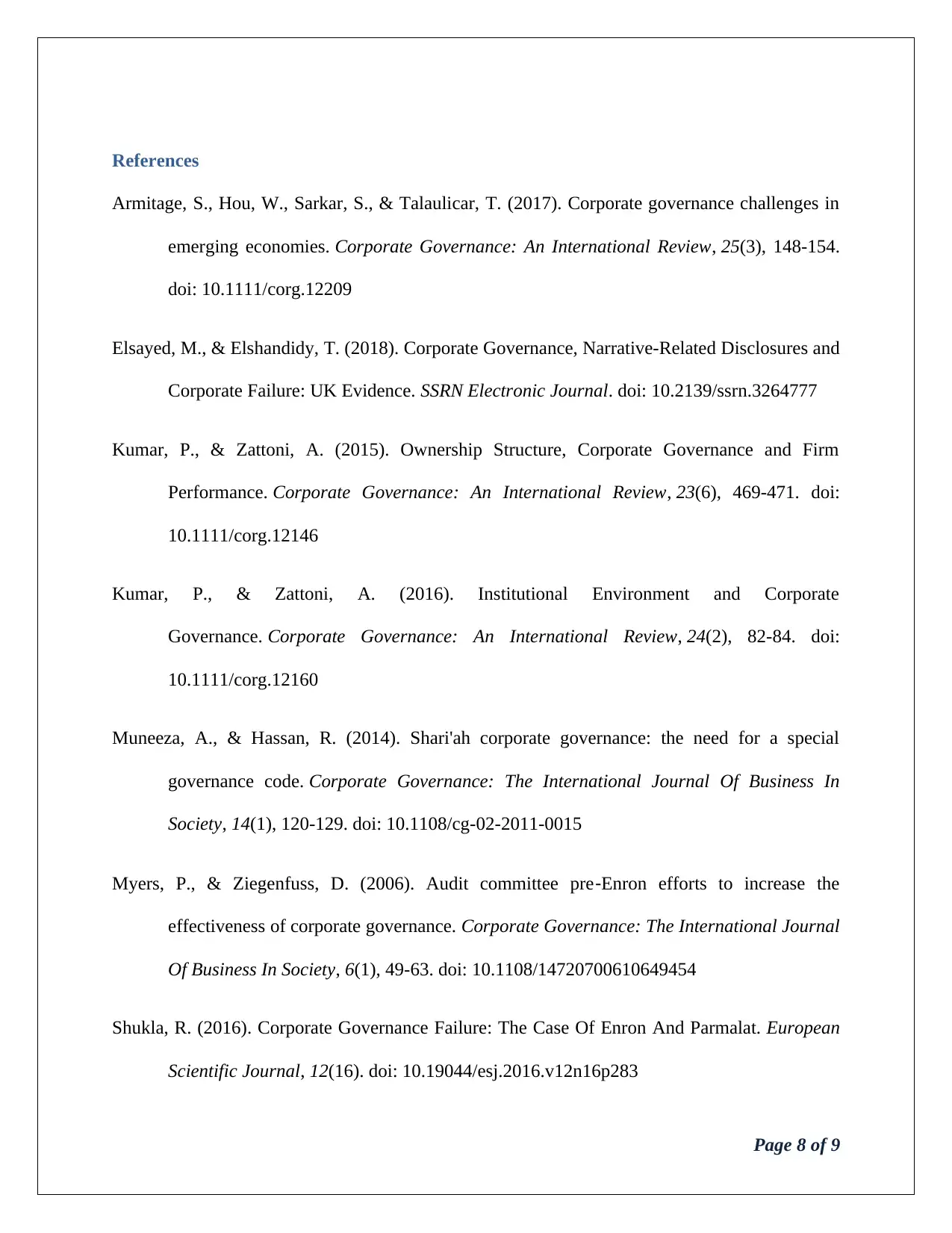
References
Armitage, S., Hou, W., Sarkar, S., & Talaulicar, T. (2017). Corporate governance challenges in
emerging economies. Corporate Governance: An International Review, 25(3), 148-154.
doi: 10.1111/corg.12209
Elsayed, M., & Elshandidy, T. (2018). Corporate Governance, Narrative-Related Disclosures and
Corporate Failure: UK Evidence. SSRN Electronic Journal. doi: 10.2139/ssrn.3264777
Kumar, P., & Zattoni, A. (2015). Ownership Structure, Corporate Governance and Firm
Performance. Corporate Governance: An International Review, 23(6), 469-471. doi:
10.1111/corg.12146
Kumar, P., & Zattoni, A. (2016). Institutional Environment and Corporate
Governance. Corporate Governance: An International Review, 24(2), 82-84. doi:
10.1111/corg.12160
Muneeza, A., & Hassan, R. (2014). Shari'ah corporate governance: the need for a special
governance code. Corporate Governance: The International Journal Of Business In
Society, 14(1), 120-129. doi: 10.1108/cg-02-2011-0015
Myers, P., & Ziegenfuss, D. (2006). Audit committee pre‐Enron efforts to increase the
effectiveness of corporate governance. Corporate Governance: The International Journal
Of Business In Society, 6(1), 49-63. doi: 10.1108/14720700610649454
Shukla, R. (2016). Corporate Governance Failure: The Case Of Enron And Parmalat. European
Scientific Journal, 12(16). doi: 10.19044/esj.2016.v12n16p283
Page 8 of 9
Armitage, S., Hou, W., Sarkar, S., & Talaulicar, T. (2017). Corporate governance challenges in
emerging economies. Corporate Governance: An International Review, 25(3), 148-154.
doi: 10.1111/corg.12209
Elsayed, M., & Elshandidy, T. (2018). Corporate Governance, Narrative-Related Disclosures and
Corporate Failure: UK Evidence. SSRN Electronic Journal. doi: 10.2139/ssrn.3264777
Kumar, P., & Zattoni, A. (2015). Ownership Structure, Corporate Governance and Firm
Performance. Corporate Governance: An International Review, 23(6), 469-471. doi:
10.1111/corg.12146
Kumar, P., & Zattoni, A. (2016). Institutional Environment and Corporate
Governance. Corporate Governance: An International Review, 24(2), 82-84. doi:
10.1111/corg.12160
Muneeza, A., & Hassan, R. (2014). Shari'ah corporate governance: the need for a special
governance code. Corporate Governance: The International Journal Of Business In
Society, 14(1), 120-129. doi: 10.1108/cg-02-2011-0015
Myers, P., & Ziegenfuss, D. (2006). Audit committee pre‐Enron efforts to increase the
effectiveness of corporate governance. Corporate Governance: The International Journal
Of Business In Society, 6(1), 49-63. doi: 10.1108/14720700610649454
Shukla, R. (2016). Corporate Governance Failure: The Case Of Enron And Parmalat. European
Scientific Journal, 12(16). doi: 10.19044/esj.2016.v12n16p283
Page 8 of 9
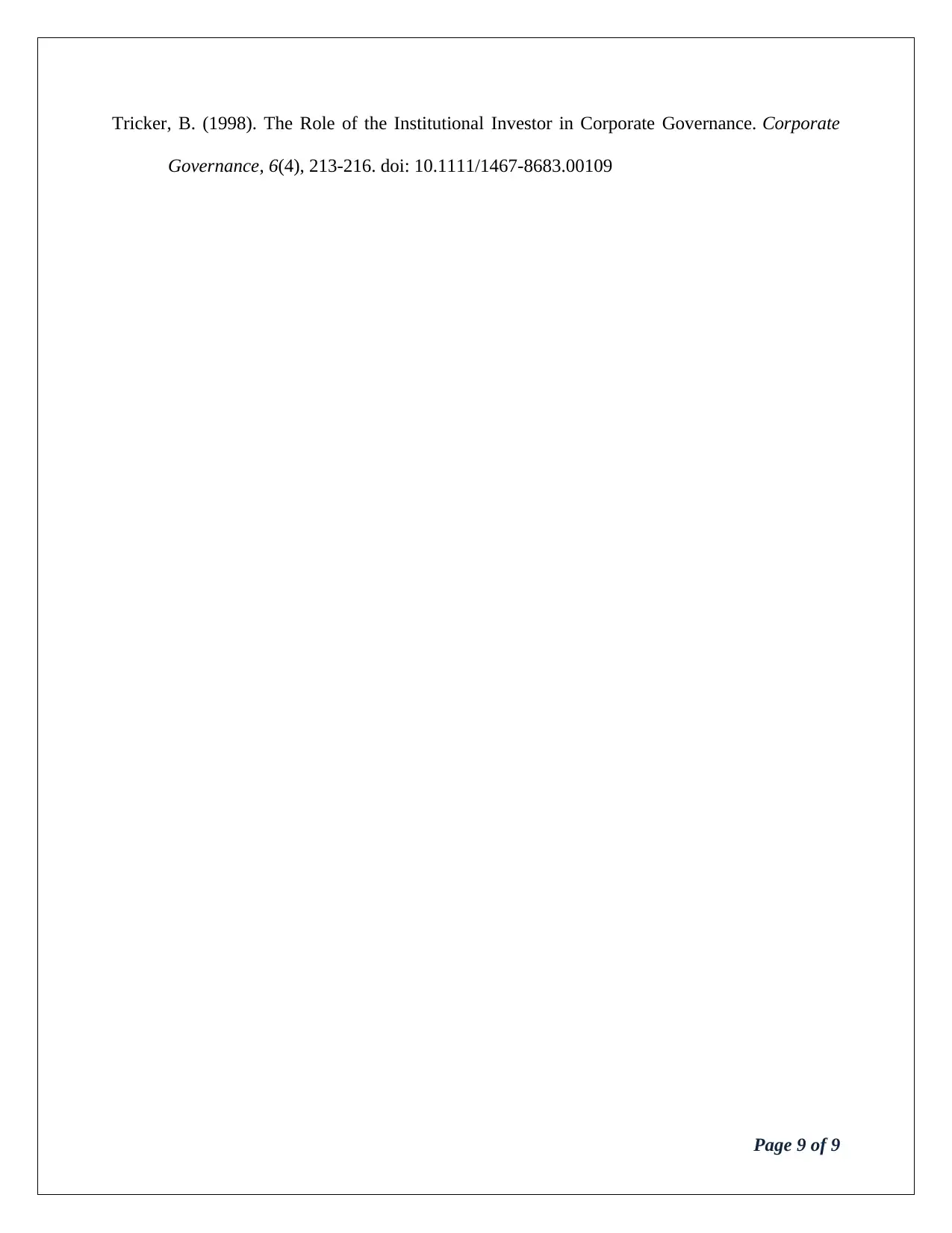
Tricker, B. (1998). The Role of the Institutional Investor in Corporate Governance. Corporate
Governance, 6(4), 213-216. doi: 10.1111/1467-8683.00109
Page 9 of 9
Governance, 6(4), 213-216. doi: 10.1111/1467-8683.00109
Page 9 of 9
⊘ This is a preview!⊘
Do you want full access?
Subscribe today to unlock all pages.

Trusted by 1+ million students worldwide
1 out of 9
Related Documents
Your All-in-One AI-Powered Toolkit for Academic Success.
+13062052269
info@desklib.com
Available 24*7 on WhatsApp / Email
![[object Object]](/_next/static/media/star-bottom.7253800d.svg)
Unlock your academic potential
Copyright © 2020–2025 A2Z Services. All Rights Reserved. Developed and managed by ZUCOL.



